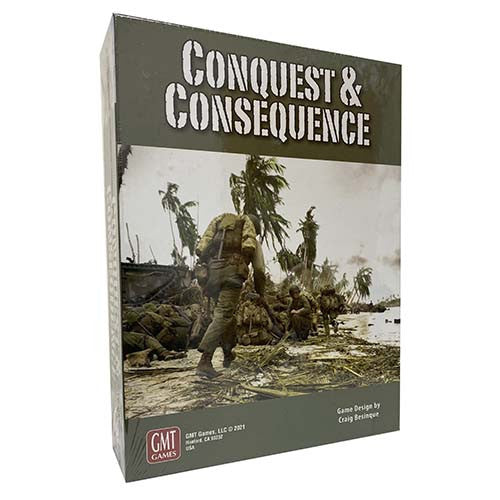Conquest and Consequence brings the Triumph & Tragedy system to the Pacific/East Asia theater during the same 1936-1945 time period. Like T&T, it is designed for three players, maintaining the three-sided dynamic that adds so much variety and intrigue to the system. Those three sides are:
- Militarist Japan, the first Asian power to modernize, which seeks to replace the European colonial empires in East Asia with a true “all-Asian” empire, with itself as the natural leader.
- The Communist Soviet faction, which is comprised of the Siberian USSR and the Red Chinese revolutionaries.
- The Capitalist USA faction, which consists of the United States, the British Empire, and the struggling regime of Nationalist China.
The game begins in 1936 with the Militarists in control of Japan and expansion on the agenda. Its [war] industry is well-developed, but it is weak in population and particularly resources. Its battle-hardened army has easily overrun resource-rich Manchuria, and a weak China awaits. Japan (like Germany in T&T) has the early initiative due to its well-prepared military. Will it:
- Move south into China?
- Take the “Northern Road” into resource-rich east Siberia (as favored by the army)?
- Pursue the “Southern Road” to the oil-rich Dutch East Indies advocated by its navy?
- Or bide its time, seeking a better position via diplomatic arrangements with neutrals including independent Chinese warlord states?
Japanese aggression in China will likely irritate the sleeping giant that is the USA, but it is far away across the wide Pacific, and Japan has special naval abilities that allow it to compete at sea.
The Red Chinese have just completed their Long March and re-established their base in inland Shaansi, far from areas of Japanese (or Capitalist) interest. The Red Chinese are very weak militarily but have a secret weapon: Partisans. These are non-military “political” organizations (represented on-map with cardboard counters) that are difficult to eradicate, multiply if ignored, and can be converted into military units when desired (this being ill-advised without sufficient concentration). The Soviet Union, also acutely aware of Japanese expansionism, is desperately fortifying eastern Siberia, which is otherwise thinly defended. Nationalist China is aware of the Japanese threat but must also deal with the internal Communist threat. The United States is disarmed, disinterested, and distracted by the Great Depression. The British Empire is woefully under-defended and overconfident. The USA alliance must build up its economy while somehow improving the military capabilities of the British Empire, Nationalist China, and itself.
The game combines the Pacific naval war and the land war in Asia (including the Chinese Civil War), both equally weighing upon victory. The naval war is dramatic, featuring short, decisive battles and expanded roles for airpower and island bases. In the tradition of Triumph & Tragedy, the three-sided aspect features negotiation, diplomacy, and subterfuge within a multitude of strategic possibilities. Like T&T, the game allows players freedom to diverge from the inclinations and policies of the historical actors and plays in 4-6 hours of constant tension and involvement.
Fast Delivery and Professional Packaging
Thanks to our longstanding association with UPS FedEx DHL and other major international carriers, we are able to offer a variety shipping options. Our warehouse staff are highly trained and will pack the goods according to our exact and precise specifications. Before shipping, your goods will be carefully inspected and secured. Everyday, we send to thousands of customers in multiple countries. This is a sign of our commitment to be the largest online retailer globally. Warehouses and distribution centers are located throughout Europe as well as the USA.
Note: Orders containing more than one product will be assigned a distinct processing time, depending on the specific item.
Before shipping, we will inspect the ordered items thoroughly before sending the items. Most orders today are shipped in 48 hours. The delivery time is between 3-7 working days.
Returns
The stock is dynamic and we are unable to completely manage it because of the fact that many parties are involved, which includes our warehouse and factory. So the actual stock may alter at any time. Be aware that it is possible that your order will be out of stock after you have made the order.
Our policy is valid for 30 days. We are unable to replace or refund your purchase after 30 days since the purchase.
In order to be eligible for a return, your item must be in good condition and in the same condition as you received it in. It must also remain in the original packaging.
Related products
Board Games
Board Games
Board Games
Board Games
Board Games
Board Games
Board Games
Board Games
Board Games
Board Games
Board Games
Board Games
Board Games
Board Games
Board Games
Board Games
Board Games
Board Games
Board Games
Board Games
Board Games

















































